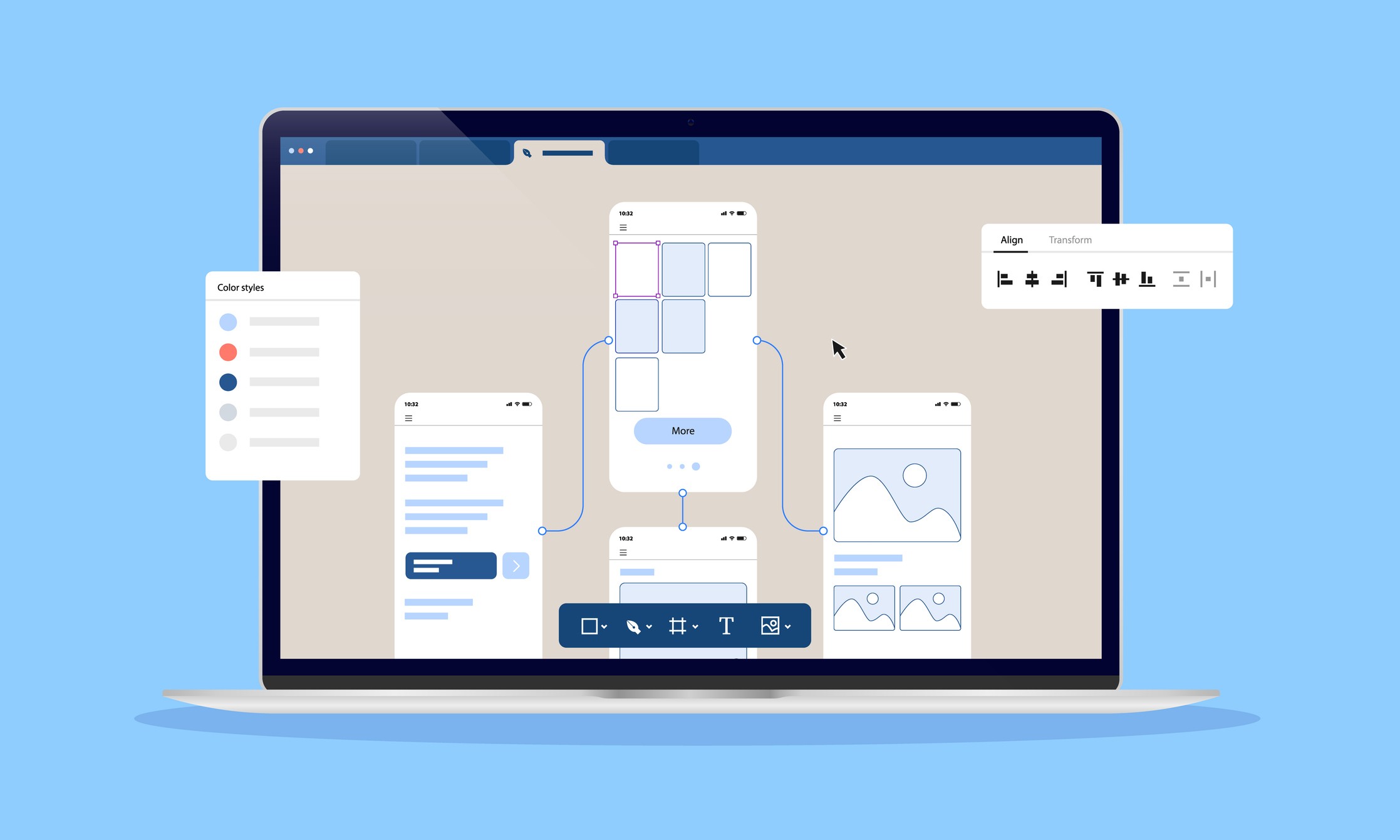Having an app idea is exciting, whether it came to you while solving a personal frustration, during a team brainstorm, or out of the blue. But once the idea is there, the next steps can feel overwhelming. How do you know if it’s viable? Where do you even begin? And how do you avoid wasting time or money on the wrong things?
These are common questions, and it’s completely normal to feel stuck at the beginning. Many successful apps started with the same uncertainty. The good news is: you don’t need a background in tech or a detailed business plan to move forward, you just need a clear, informed process to guide your next steps.
Step 1: Validate Your App Idea Before You Invest
The first and most important step is to validate your app idea before committing time or budget. It’s tempting to jump into development right away, but a bit of early research can save you from costly mistakes and help you build something people actually want.
Outline the Problem You’re Solving
Every strong app idea starts with a real problem. Before you sketch screens or write code, take time to understand the challenge from your users’ perspective.
Talk to Potential Users
One of the most valuable things you can do early on is to have real conversations with people who experience the problem your app idea aims to solve. Start by reaching out to friends, colleagues, or contacts within your network who fit your target audience. These don’t have to be formal interviews, casual conversations often surface the most useful insights.
Focus on asking open-ended questions about their daily workflows, pain points, and any workarounds they currently use. Listen for recurring frustrations or tasks that feel inefficient or overly complicated. The goal isn’t to pitch your idea, but to understand the problem deeply from their perspective.
Use Surveys, Forums, and Online Communities
If you don’t have direct access to your target users, the internet offers plenty of ways to observe and engage with them. Platforms like Reddit, Quora, Facebook Groups, Discord communities, and niche industry forums can be goldmines for honest, unfiltered feedback. Join the conversations, search for keywords related to your app idea and pay attention to what people are complaining about, asking for, or struggling with.
You can also create a short survey using tools like Google Forms or Typeform and share it in relevant groups, newsletters, or subreddits. Ask simple questions that help you spot trends: What’s your biggest challenge with [topic]? Have you used any apps to help with this? What did you like or dislike? Over time, you’ll start to notice patterns that point toward real needs and real opportunities.
Research Existing Apps
Before building your solution, check what’s already available. Analyzing the current landscape helps you spot opportunities and avoid repeating what’s been done.
Identify Your Competition
Start by searching app stores like Google Play and the Apple App Store using keywords related to your concept. Also look through product directories such as Product Hunt, G2, Capterra, and even niche startup listings or industry roundups. Your goal is to identify both direct competitors, apps that solve the same core problem, and indirect competitors, tools or platforms users might be turning to as a workaround.
Make a list of these apps, and organize them by their core features, pricing model, target audience, and business model. This list becomes a valuable reference point not just during planning, but later when positioning your app or pitching it to others.
What Do They Do Well? Where Do They Fall Short?
Once you’ve identified competitors, spend time exploring them in detail. If possible, download and test the apps yourself. Pay attention to how intuitive the onboarding process is, what features are emphasized, and how well the app performs on different devices. Try to experience the product from the perspective of your target user.
Next, dig into user reviews and ratings, especially on app stores, Reddit threads, and social media. Look for consistent praise: what features do users love? What keeps them coming back? Just as importantly, look for complaints, missing features, or confusion. Patterns in negative feedback can highlight areas where users are still struggling and where your app idea could stand out.
You can also go deeper by analyzing their websites and marketing. What language do they use to describe their product? Who are they targeting? How do they position themselves differently from others? These observations will help you refine your own messaging and carve out a distinct value proposition.
If you have access to tools like SimilarWeb or BuiltWith, you can even explore traffic sources, tech stacks, and user demographics to better understand how these apps operate behind the scenes. The more informed you are about the competition, the better equipped you'll be to build something that not only fills a gap but solves the problem more effectively.
Build a Lean Value Proposition
Now that you’ve explored the problem and surveyed the competitive landscape, it’s time to distill your app idea into a clear and focused value statement. This is a one-sentence summary that answers two fundamental questions: What does your app do? and Why would someone choose it over any other option?
Think of this as your app’s elevator pitch, not for investors, but for clarity. It should explain the core function and benefit without jargon or unnecessary details.
For example:
- “A scheduling app that helps freelancers manage appointments and payments in one place.”
Or:
- “A language learning app that uses AI-driven conversations to help beginners practice real-world dialogue.”
This sentence becomes the foundation for everything that follows, from your landing page copy to development priorities. If you can’t clearly express the value, your users probably won’t see it either.
Define What Makes It Different or Needed
Once you’ve nailed down what your app does, the next step is identifying why it matters. This is where your unique value proposition comes in. What makes your app idea stand out in a crowded market?
Is it faster or simpler than existing solutions? More affordable? Designed for a specific niche or underserved audience? Maybe it solves a problem in a way no one else has tried yet. Your differentiation doesn’t need to be dramatic, it just needs to be clear and relevant to the users you're targeting.
For example:
- Your competitors might be bloated with features; yours could focus on speed and ease of use.
- Maybe existing tools serve enterprise clients, and you’re building something for solo professionals or smaller teams.
- Perhaps your app uses a new interaction model (voice, gesture, or automation) to simplify a tedious task.
Once you’ve identified what sets your app apart, use that insight to guide every decision. From the features you prioritize to how you market the app, your value proposition should stay front and center.
Step 2: Map the Journey from Idea to App
With your app idea validated, the next step is to start shaping it into a practical, buildable project. That doesn’t mean jumping straight into code. Instead, you’ll want to define how the app works, what it includes, and how users will interact with it.
This planning stage is where good ideas become clear, focused, and achievable.
Sketch the User Experience
You don’t need a design background to sketch out your app. The goal here isn’t to create pixel-perfect screens, it’s to understand how people will move through your app and accomplish their goals.
Start with Simple Wireframes
You don’t need to be a designer to start shaping your app idea visually. Begin with basic wireframes, simple sketches of your app’s key screens and interactions. Tools like Figma, Balsamiq, Miro, or even pen and paper work just fine at this stage.
Focus on User Flow, Not Visual Design
When creating wireframes, concentrate on user flow, the steps a person takes to move through the app. Think through each action from the user's perspective: What’s the first thing they see? What do they tap next? What happens if they get stuck? Mapping out this journey helps you identify which screens are truly necessary and which features directly support the core function of your app.
Break Down Features into Must-Haves and Nice-to-Haves
Not every idea needs to make it into version one. It’s easy to get carried away with features, but keeping things focused early on gives you a much better chance of launching successfully.
Use the MoSCoW Method
This method helps you and any future collaborators stay on the same page, and it prevents feature creep from slowing down your launch.
Categorize features into:
- Must-Haves: Core features without which the app wouldn’t function
- Should-Haves: Important features, but not absolutely essential
- Could-Haves: Nice extras that can wait
- Won’t-Haves (for now): Ideas to revisit later
Start with a Minimum Viable Product (MVP)
Your Minimum Viable Product (MVP) is the simplest version of your app that still delivers real value to users. It’s not a prototype, it’s a working product, just focused and lean.
An MVP allows you to launch sooner, gather feedback, and make smarter decisions about what to build next. It’s how successful apps grow without wasting resources.
By mapping the journey from your app idea to a real, usable MVP, you’ll create a strong foundation for development and make your vision easier for others (developers, investors, or co-founders) to understand and support.
Keep Version 1 Focused and Purposeful
Your goal with version 1 is not to deliver a full, polished platform, but to create a Minimum Viable Product (MVP): a usable version that delivers clear value with the smallest possible set of features. That core use case should shape the features you prioritize, the user flows you design, and the feedback you gather. Keeping things focused doesn’t limit your vision, it gives you a strong foundation to build on.
For example, if your app is meant to help users track habits, the first version might focus only on logging one or two habits per day with basic reminders. Later, you can explore analytics, social sharing, or gamification but only once the core behaviour is validated and working well.
Avoid Overbuilding
One of the most common missteps in app development is trying to include everything in version one. While it might feel like you’re delivering more value, overbuilding often backfires: it adds complexity, delays your launch, inflates your budget, and makes it harder to pinpoint what’s actually working.
Every extra feature you add introduces more code to test, more edge cases to consider, and more potential confusion for first-time users. Instead of helping, it can dilute your value and make user feedback harder to interpret.
Ask yourself with every feature: Is this essential for solving the main problem I’ve defined? If it’s not, consider saving it for a future release. Launching with a smaller, purpose-driven set of features allows you to gather targeted feedback, test real usage patterns, and iterate with confidence.
Step 3: Budget and Timeline Planning for App Projects
Once you have a clear outline for your app idea, it’s time to think realistically about budget and timeline. Even a lean app takes time, planning, and investment to build. Understanding what affects cost and where you can make smart trade-offs can help you move forward without financial surprises.
What Impacts Cost
App development costs can vary widely, depending on the choices you make early on.
Platform: iOS, Android, or Web
One of the first decisions you’ll face when developing your app idea is which platform to build for. Native apps for iOS and Android each come with their own technical requirements, testing environments, and design guidelines, doubling the work if you aim to launch on both simultaneously. A common alternative is to use a cross-platform framework like Flutter or React Native, which allows developers to write shared code for multiple platforms. While this can save time and cost, it’s not always the right fit for every app, especially those requiring heavy native integrations or high-performance animations.
Feature Complexity
The more complex your feature set, the longer your development and testing cycles will be. Features like real-time chat, user-generated content, payment systems, geolocation, or role-based permissions all add layers of logic and edge cases to handle. Even small additions like custom user onboarding or in-app notifications can require significant planning and QA time. Prioritizing core functionality early on and leaving more complex features for future phases can help keep your project manageable and on schedule.
Design Requirements
Custom visual design also has a big impact on timeline and cost. Highly stylized interfaces, interactive animations, or custom transitions often require additional frontend development time. While these can enhance the user experience, they’re best reserved for later stages unless they are central to the app’s value. A clean, user-friendly layout using system-standard components can be both cost-effective and quicker to implement without sacrificing usability.
Third-Party Integrations and Backend Systems
If your app needs to connect with external systems like a CRM, cloud database, payment processor, or email platform, be prepared for some added complexity. These integrations often depend on the quality of third-party documentation, API stability, and the need for custom workflows. Even well-documented tools can introduce delays when authentication, data syncing, or error handling doesn’t behave as expected. Plan for extra time during development and testing when working with third-party services, especially if your app relies on them for critical functionality.
Budget-Saving Strategies
You don’t need a six-figure budget to bring your app idea to life. Budgeting is about more than just numbers, it’s about setting realistic expectations and planning for steady progress. A thoughtful approach here will keep your app idea moving forward without stalling from scope creep or sticker shock.
Start with One Platform
When building an MVP, it’s often more effective to focus on a single platform, iOS, Android, or Web, rather than trying to launch on all of them at once. Choosing one based on your target audience’s preferences or habits allows you to simplify development and get to market faster. For example, if your users are primarily desktop-based professionals, starting with a web app might make the most sense. If they’re mobile-first, iOS or Android will be more appropriate.
Use Open-Source Tools / Reusable Components
You don’t need to build every piece of your app from scratch. Many developers use open-source libraries, UI kits, or ready-made components to accelerate the process and keep costs down. These tools can handle common needs like form validation, authentication, or navigation - freeing up time to focus on your app’s unique functionality. As long as they’re from trusted sources and properly maintained, these resources can offer stability and performance without bloating your app.
Partner with a Smaller Dev Team That Offers Flexible Engagement
Working with a large agency can come with a high price tag and rigid project structures. A smaller development team or boutique studio often provides a more collaborative experience, where you’re involved in the process and have greater control over pace and budget. Look for a team that offers flexible engagement models, whether that means working in sprints, building in phases, or offering strategy sessions alongside development.
Step 4: Choose the Right Development Partner
Bringing your app idea to life requires more than just technical skill, it takes collaboration, communication, and a shared understanding of your goals. The team you choose to build your app will have a direct impact on its outcome, so it's important to select the right partner based on experience, fit, and long-term potential.
Look Beyond Big Agencies
Large agencies may seem like a safe bet, but they often come with high price tags, rigid processes, and limited access to the people actually doing the work. For startups, early-stage ideas, or projects with evolving requirements, smaller teams are often a better fit.
Freelancers can be ideal for narrow-scope MVPs or quick prototypes, especially if you have a technical background or access to product management support. Make sure they’ve handled full app lifecycles, not just front-end or one-off tasks, if you’re relying on them to lead development.
Small studios or developer-owned companies often strike a balance between affordability and expertise. You’ll typically work directly with senior developers, benefit from more personalized attention, and enjoy more flexible engagement options compared to larger firms.
Look for a team that can scale with you, starting lean during the MVP phase, and expanding capacity as your app grows. This allows you to stay agile, responsive to feedback, and in control of your timeline and budget.
What to Ask Before You Hire
Asking the right questions early on can save you significant time, money, and frustration down the road. Below are a few essentials to cover in your first conversations with any development partner:
- Do you have experience with MVPs or early-stage apps?
- Not all developers are comfortable working in lean environments. Look for those who know how to build testable, functional apps quickly, and who understand that your product will evolve over time.
- How do you handle billing, changes in scope, or shifting priorities?
- Ask for clear pricing structures, examples of past budgets, and how they approach change requests. Look for transparency around deliverables and milestone-based billing, rather than vague estimates or open-ended time tracking.
- Will you challenge assumptions and offer strategic input?
- A strong partner won't just build what you ask for, they’ll ask why. They’ll raise questions, flag risks, and suggest smarter ways to solve problems. That kind of thinking saves time and money and ultimately leads to a stronger product.
Red Flags to Watch For
Spotting potential issues early can save you from major headaches down the road. Be cautious if a developer or agency:
- Overpromised timelines or simplified estimates
- If a developer guarantees a full-featured app in two weeks without thoroughly understanding your requirements, it’s a sign they’re not realistically scoping the project.
- Vague responses about technical decisions
- You don’t need to be fluent in development, but you should feel confident that your team has a plan and can explain their tech stack, hosting approach, or database strategy in a way that makes sense to you.
- Lack of version control or backup process
- Every project should be under version control and backed up regularly. If they can’t describe their process for protecting your data or rolling back changes, proceed with caution.
Step 5: Build, Test, and Iterate
Once you've mapped out your app idea, planned your features, and partnered with the right team, it's time to start building. But the most successful app projects don’t launch with every feature locked down, they grow through iteration. This phase is about progress, not perfection. The faster you can test a working version, the faster you can learn what actually works for your users.
Start Small and Iterate Fast
Resist the urge to build everything at once. A smaller, functional version of your app that people can interact with is more valuable than a polished concept that hasn’t been tested in the real world.
When developing your app idea, it’s easy to get caught up in making everything perfect before showing it to anyone. But in early stages, speed and functionality matter far more than polish. Focus on building a working demo that users can interact with, even if the interface is basic or a few features are still in progress. A functional prototype that solves the core problem gives you something tangible to test, validate, and improve. It also helps potential partners, investors, or users understand the value you're offering, without waiting months for a "finished" version.
Use Feedback Loops with Test Users
Once you have a demo or MVP, the most valuable next step is to get it into the hands of real users. Identify a small group of testers who reflect your target audience, early supporters, industry contacts, or users from your research phase and ask them to use the app naturally.
Encourage candid feedback by asking questions like: Was anything unclear? What did you expect to happen here? What’s missing?
Treat this as an ongoing loop, not a one-time task. Each round of feedback helps you refine your app idea, prioritize improvements, and build features based on real needs instead of assumptions.
Testing is Not Optional
Even a basic app can break in unexpected ways. Thorough testing ensures that your app idea delivers a smooth experience from the start and protects your reputation as you grow. Treat each version as a stepping stone, not the final product. The key is to stay responsive, adaptable, and willing to improve based on real-world input. That’s how a strong app idea evolves into something people want to use again and again.
Real-Device Testing
While simulators are useful during development, they can only take you so far. To ensure your app idea performs reliably in the real world, it’s essential to test on the actual devices your target users will use across different screen sizes, operating systems, and hardware.
Real-device testing helps uncover issues with responsiveness, battery usage, connectivity, or hardware-specific quirks that emulators often miss. It also gives a clearer picture of how the app feels and behaves in day-to-day conditions, which is important for delivering a smooth and frustration-free user experience.
User Acceptance Testing (UAT)
User Acceptance Testing is your chance to see how real users interact with your app before you officially launch. Unlike developer testing, UAT focuses on the user’s experience: Can they complete key tasks without assistance? Do they encounter confusion or dead ends?
Invite a small group of testers to use the app naturally in real-world scenarios, and observe how well your assumptions hold up. This process often highlights gaps in usability or logic that weren’t obvious during development. Insights from UAT are invaluable for refining your final release and ensuring the core functionality delivers as intended.
Use Focus Groups, if Possible
If your timeline and resources allow, conducting a focus group can provide another layer of valuable feedback. A focus group doesn’t have to be formal, a small session with 5–8 people from your target audience can surface deep insights about how users perceive and experience your app.
Walk participants through key tasks, observe their reactions, and take note of recurring questions or friction points. Pay close attention to body language and spontaneous comments, as these often reveal more than structured surveys. Even a few informal sessions can highlight patterns that help you fine-tune your app idea before launch.
Step 6: Launch Smart, Not Loud
After weeks or months of planning, building, and testing, launching your app idea can feel like the finish line, but it’s actually just the beginning. A well-executed launch sets the stage for growth, user trust, and long-term success. Instead of rushing to get as many users as possible on day one, a smarter approach is to start small, learn, and adjust.
Soft Launch for Real Feedback
Going live doesn’t have to mean going big. A soft launch, a limited release to a smaller, controlled audience, is one of the most effective ways to catch issues early and refine your app before wider exposure.
Before going live to the public, consider doing a soft launch by releasing your app to a small group of users who closely reflect your target audience. This might include beta testers, early newsletter subscribers, existing customers, or individuals you spoke with during your initial research. Allow them to use the app in real-world conditions on their own devices, within their own routines, without detailed instructions. This kind of limited release helps you observe how the app performs in practical use, and whether it aligns with your original goals.
During this soft launch, actively collect feedback from your test group. Track both qualitative insights and hard data: what features are they using most? Where do they get stuck? Are there unexpected bugs or performance issues? Pay close attention to common frustrations, feature requests, and any patterns in user drop-off.
This focused feedback loop gives you the opportunity to fix problems, clarify confusing flows, and refine usability before releasing to a larger audience. It's far more effective to adjust based on ten thoughtful users than to launch publicly and watch a hundred quietly abandon the app due to issues you could have caught early.
Know Your Post-Launch Plan
Launching an app isn’t a one-time event, it’s the start of an ongoing relationship with your users. A clear post-launch plan will help you respond quickly, improve continuously, and retain your early adopters.
Even with thorough pre-launch testing, real users will inevitably encounter edge cases and unexpected issues once your app idea is live. That’s normal and it’s why having a solid process for handling bug reports is essential. Make it easy for users to report problems, whether through an in-app form, support email, or feedback tool. Assign a clear priority level to each issue and have a system in place for tracking, fixing, and deploying updates efficiently. Quick responses to bugs not only improve the user experience but also show users that your team is active, responsive, and committed to quality.
User Onboarding Support
First impressions matter, especially in the first few minutes after someone downloads your app. If users don’t quickly understand how to use it, they’re likely to abandon it altogether. A well-planned onboarding experience can prevent this. Consider including a quick-start guide, interactive walkthroughs, tooltips, or even a simple welcome email with helpful links.
Keep it light but informative, and tailor it to your app’s complexity. Reducing early friction boosts engagement and retention, turning curious first-time users into confident, long-term ones.
Feature Roadmap
After launch, users often want to know what’s coming next. Having a clear feature roadmap, even if it’s just internal, helps keep your team aligned and sets expectations for your audience.
A roadmap doesn’t need to be overly detailed, but outlining upcoming improvements, planned features, or known limitations can guide development and customer support. Sharing parts of it publicly can also build trust and anticipation, giving users a reason to stay engaged and check back for updates. Transparency around your app’s evolution shows that your app idea is not a one-off build, but a growing and improving product.
BONUS: Out of the Box Ways to Evolve Your App Idea
Not every step toward launching an app happens inside a development environment. Sometimes, the best way to shape your app idea is to test it outside of the build process, with real audiences, in creative, low-risk ways.
These strategies can help validate demand, spark early engagement, and even attract potential users or collaborators ... before you’ve written a single line of code.
Run Low-Cost Facebook or Google Ads to Gauge Interest
This kind of test can help you answer questions like: Is this a pain point worth solving? Are people curious enough to learn more?
Set up a simple ad campaign targeting people who might benefit from your app idea. Instead of selling the app, test value propositions. Try different headlines and angles to see what people respond to. Use click-through rates or conversions (such as email signups) as early signals of interest.
Create a Pre-Launch Landing Page
You can use tools like Carrd, LaunchRock, or a simple WordPress page to create a lightweight, effective landing page in under a day.
A single-page site with a short description of your app idea, a few screenshots or mockups, and a call-to-action (like "Join the waitlist") can go a long way. It also gives you a chance to collect email addresses from interested users, which becomes valuable when you're ready to launch.
Use Explainer Videos or Interactive Demos
This approach is especially helpful if your app idea is complex or solves a problem users may not immediately understand. A short video walkthrough, animated explainer, or clickable prototype (built in Figma or InVision) can help potential users understand your concept without needing a full build.
Share these on social media, in email campaigns, or through private links to gauge reactions and gather feedback.
Talk to Micro-Influencers in Your Niche
Micro-influencers often have more direct conversations with their followers and can be a great source of honest insights or potential beta testers. Reach out to small but engaged creators, bloggers, or content creators within your target space.
Share your idea and ask for input, not promotion. Many are open to providing early feedback and may even become advocates if the concept resonates.
You don’t have to wait until development is complete to start growing your app. By exploring creative, low-cost ways to test and promote your app idea, you can build momentum, gather validation, and refine your direction without overextending your budget or timeline.
Start Small, Think Big
Turning your app idea into a real, working product doesn’t require a massive budget or a full team from day one. What matters more is clarity, focus, and a willingness to learn as you go. Every successful app started somewhere, often with a simple version, a handful of users, and a clear purpose. Starting small gives you room to adapt, refine, and grow without getting locked into assumptions or overspending early on.
By taking things step by step, validating your idea, planning your features, partnering with the right team, and launching with intent, you give your project a strong foundation built on insight, not guesswork. Your app idea doesn’t need to be perfect to be worth pursuing. It just needs momentum.




